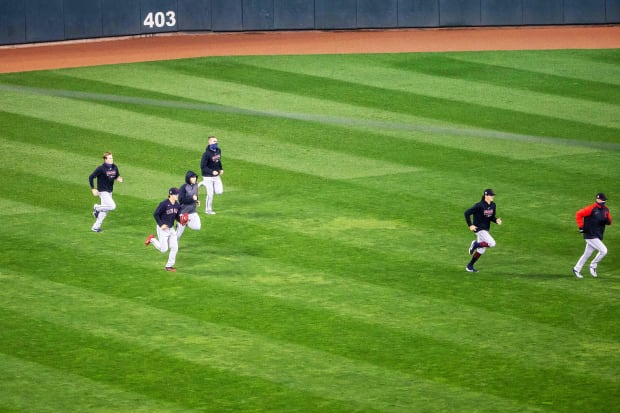Welcome to The Opener, where every weekday morning during the regular season you’ll get a fresh, topical story to start your day from one of SI.com’s MLB writers.
There are two parts to every baseball altercation. One is everything that happens on the infield—where the scuffle begins and the dugouts quickly empty out. And the other is the journey through the outfield, long and traditionally futile, in which relievers dutifully cover hundreds of feet from the bullpens just to get a glimpse of the action.
Or put more simply:
“By the time we get down there, it's all broken up,” says Pirates reliever David Bednar. “And you’ve just gotta walk back. Everybody’s out of breath, and everybody needs some oxygen.”

Jesse Johnson/USA TODAY Sports
They realize from the start that all their effort is probably for naught: They often run all the way out there only to turn around for the walk back. While all their other teammates are either fighting or trying to stop each other from fighting, the relievers are stuck crossing the entire field. (On the rare occasion they find the brawl still going once they get there—they have bigger problems to worry about.) They realize their run is likely pointless. They know it’s a lot of ground to cover and, frankly, they would sometimes rather just not do it. But it’s an important piece of the process—complete with its own politics and plenty of space for idiosyncrasy—and relievers agree: It’s a trip they have to make.
“Oh, you’ve gotta sprint out to be in there for your boys,” says Blue Jays reliever Jordan Romano. “If you’re walking or jogging, that’s not a good look. You’ve gotta sprint at full speed.”
Which does come with some risks.
“You’ve been sitting for a while, and then you’ve got that full sprint,” Romano laughs. “So you’re worried about your hammies—you just hope one doesn’t blow.”
If a baseball team is a brotherhood, the bullpen can sometimes feel a bit like a set of step-brothers. Relievers are physically distant from their teammates in the dugout and bound by a different set of routines. But a bench-clearing can feel like a chance to demonstrate their commitment to the larger group: They know they’re far away, and they know they’ll probably be too late, but they’re still making the journey, distance (and barriers) be damned.
“I keep getting yelled at for jumping the fence,” sighs White Sox reliever Liam Hendriks, noting that he did so most recently during Chicago’s bench-clearing with Minnesota earlier this month. “It was a lot further down than I thought.” (A great way to show competitive spirit, perhaps, but not exactly the best technique from a safety perspective.) But his goal every time is to be the first reliever out there, and sometimes, that means jumping the fence rather than waiting for someone to open the gate. He’ll take any edge he can get: At 33, he knows that he’s not quite as quick as some of his younger teammates. But that hasn’t lessened his desire to stand out as the fastest relief pitcher in every scuffle—and he has a good source of inspiration.
With the Blue Jays in 2015, Hendriks was teammates with LaTroy Hawkins, then 42 years old and in the final season of his career. Their first bench-clearing was memorable. “He was running and screaming at everybody else, like, You cannot let a 42-year-old beat you guys in, and then proceeded to absolutely kick our asses on the run in,” Hendriks recalls. Now he tries to do the same.
So he sprints as fast as he can for the bragging rights. And for another reason, too: If he makes a big show of running, then on the off-chance the brawl is still going when he gets there, no one will notice that he isn’t actually equipped to participate.
“I can’t fight whatsoever,” Hendriks explains. “So I like the look of me having that animosity … But the fact that I can’t fight is a dead giveaway that it’s all an act, so if I can continue that facade on for as long as I can, it’s probably better.”
For some, though, it doesn’t feel so much like a competition. It’s a show of solidarity—which means sure, you have to run, but you don’t necessarily have to rush to be the first.
“You can’t not go out there,” says the Diamondbacks’ Joe Mantiply. “It’s just having your teammates’ back, and to me, it takes no talent to be a good teammate… But I just stay with the flow. Maybe middle of the pack. You’ve got to make sure you don’t hurt yourself.”
It’s a trek. Which means that once the relievers actually get going, there’s plenty of time for their minds to turn to the inevitable return journey. Whatever adrenaline gets them out of the bullpen, if they see the scuffle beginning to break up when they’re only halfway there, well—it’s easy for the spark to fade a little as they start to consider the way back.
“It’s always a quick rush at the beginning, but you just realize, you’re going to be out of breath and walking back here pretty soon,” says Clay Holmes of the Yankees.
That holds even if they come out with the purest of motivations—not to come to blows, not to show off their speed, but to break up the whole thing.
“You don’t want to fight,” Orioles reliever Jorge López says of what he’s thinking when he’s running out. “You just want to manage the problem.”
But even that usually seems fruitless.
“You never get there,” he says with a laugh.
Catch MLB action all season long with fuboTV: Start a trial today.







